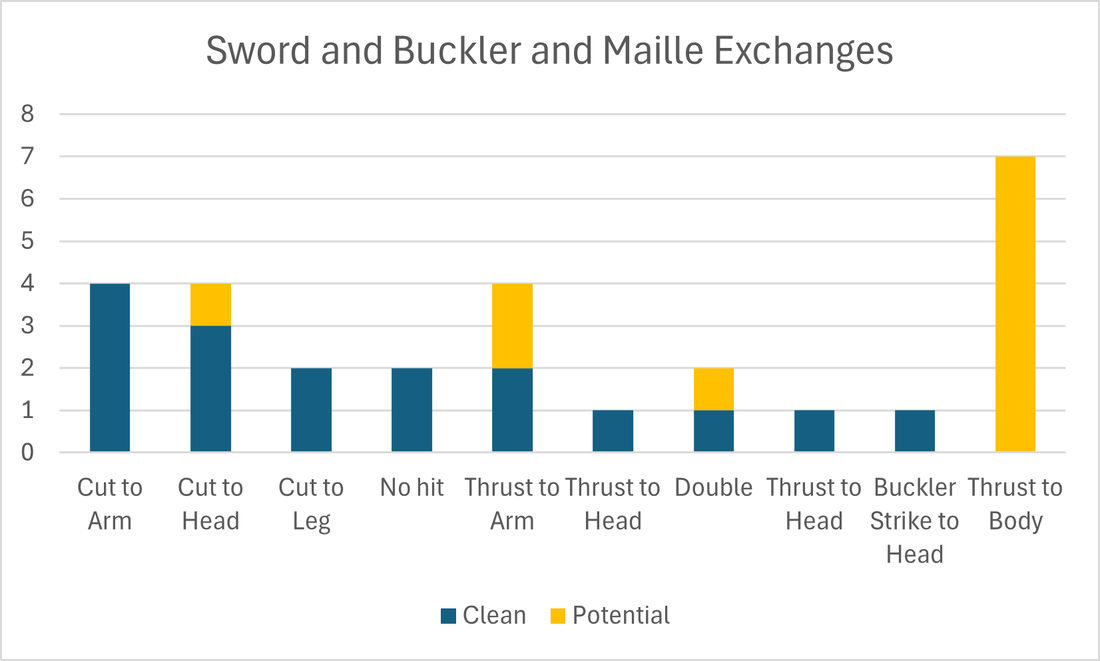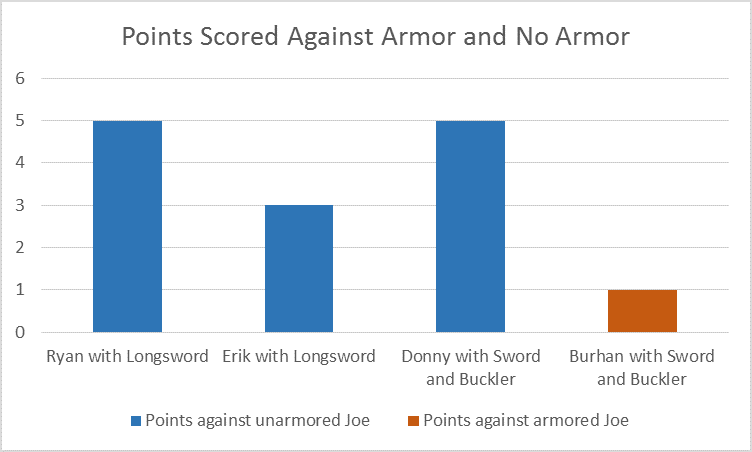|
In the HEMA community, sword and buckler are viewed as unarmored weapon sets, and while this is largely true, it is not the complete picture. Manuscript examples showcase several soldiers wearing different levels of armor while being armed with swords and bucklers. So, this begs the question, how does wearing maille change a sword and buckler fight? Roland Warzecha, based on his analysis of manuscripts featuring armor and sword and buckler, stated that he did not see any indication of specialized armored fencing systems that would fundamentally differ from fighting out of armor in the age of maille. Today, Jerod and I will be putting this hypothesis to the test. Summary of ExchangesOverall, we had 27 exchanges in this experiment, with a variety of results. The exchanges are summarized in the table below: After summarizing the exchanges, the results were grouped into categories to see the overall targets. Potential results were strikes against the maille. We cannot say whether the thrusts against the maille would penetrate the armor to defeat our opponent. With a layer of maille and a layer of gambeson, it is possible that the armor would have prevented some of those thrusts from injuring the fencer. Quality of the maille, damage received previously to the armor, the geometry of the sword, and force of the thrust all factor into whether the potential hits would have ended the fight. It is also worth noting that while we did not treat cuts to maille as hits in an exchange and continued fighting, there is an art that depicts maille being cut through in combat. During our exchanges, some rings were broken which adds evidence that the maille was beatable with thrusts. ObservationsWhen looking at the exchanges based on fencer, it becomes clearer the strategies each fencer used. Jerod generally favored the thrust, particularly on the opening action of an exchange. In many cases, he was able to connect with a thrust. Donny, on the other hand, seemed to still use cuts which benefited him when targeting the limbs. However, it is worth noting that cuts to the leg were not a valid target for Jerod because of Donny’s leg armor. This could be evidence that the more maille a fencer is wearing, the less likely their opponent is to cut. Jerod noted that with the extra armor, thrusting without our sword and buckler hands close seemed less risky than when we fought without armor. However, all of the cuts to the arm were delivered against Jerod, possibly indicating that his arm was not as safe as he thought when his hands were separated. Based on the spread of exchange-ending hits, it does not seem maille alone impacted our fencing strategies. The limbs, head, and body were all targeted throughout the exchanges. While there were several occasions where a cut landed on the maille (which did not stop the exchange), which set up new attacks, this seemed to be similar to when one fencer goes to deliver an attack that fails to connect. There were also more blade grabs than in unarmored exchanges, but this setup of follow-up strikes is similar to buckler-strikes. One type of attack did dominate the exchanges. Thrust to the torso became much more prevalent than Jerod, and I usually see in our exchanges. Jerod noted that he delivered opening thrusts more than he normally does in the armor. This is likely because the torso, being the most significant target area, and the other regions protected by armor became a more opportune target than limbs, which are more commonly hit in our exchanges. Interestingly enough, this emphasized our I.33 technique because keeping our sword and buckler hands close protected our torso and helped us set up thrusts more easily. On top of that, with the extra armor, thrusting without our sword and buckler hands close seemed less risky than when we fought without armor. Closing ThoughtsBased on our results, I believe Warzecha’s hypothesis that maille did not warrant special techniques and systems is plausible. The true advantage of maille is reducing the likelihood of a strike debilitating the combatant. However, because the armor can still be beaten, fencers must still avoid strikes when possible. Both Jerod and I’s doubles came early when we acted as if we were invulnerable because of the armor. This approach only resulted in two dead idiots. Once we settled in and started using more technique, the exchanges were much cleaner. However, maille alone is not the only armor shown in art paired with sword and buckler. That is an experiment for another day.
0 Comments
Funky Buckler and Vier Blossen Historical Fencing paired up to see how armor impacts the fight. This blog will explore the data from the workshop and what can be learned from this experiment. This experiment and workshop was inspired by the Knight of Hope. Experiment Setup Fencers were expected to fight unarmored and were allowed to choose any weapon they wanted. Two fencers picked longsword while the other two picked sword and buckler. They would fight against Joe using a longsword while he was unarmored and when he was armored. The unarmored results would be used as the baseline when comparing the performance of armor. Fencers would fight to 5 points. Points were determined by the following hits:
Fencers were advised to not stop attacking until their opponent acknowledged that they were hit. This was decided to reduce potential doubles or after-blows that may occur from one fencer thinking they had struck their opponent and stopping while the opponent continued to attack. The Results Unsurprisingly, armor dramatically improved Joe’s performance. While Joe was struck by his opponent while he was unarmored, he was able to make three of the four opponent’s fail to land and attack when he was in armor. The Outlier – Burhan Burhan, who was unable to hit Joe while Joe was unarmored, was able to deliver a thrust past Joe’s armor. Even with Burhan earning the title of MVP (Most Valuable Peasant) for the workshop, he felt that he only achieved the hit by pure dumb luck. Armor verses Multiple Opponents Joe successfully defeated a pair of sword and buckler fencers but lost to a pair of longsword fencers, taking one with him. When an armored Joe fought five opponents, he successfully hit three opponents before being hit himself. While the fight ended when Joe was hit, this assumes that he would not have continued fighting after being struck by a sword. Joe was able to isolate each opponent and defeat them before moving on to the next opponent. It was not until he was surrounded and all the opponent’s closed on him that he was defeated. Potential Improvements Against Armor One noteworthy data point is that none of Joe’s opponents had experience fighting someone in armor. It is possible that someone who has fought armored combatants would have had more success even if they were unarmored. Some of the opponents for Joe had experience with thrusting systems that may have aided in finding gaps in armor. As mentioned in the video, thrusting into the gaps were far more difficult than expected. Closing Remarks Armor is incredibly effective. Even against multiple opponents, the armored fighter had a chance to fight and survive. The ability to reduce the target zone while also being able to fight more aggressively cannot be underestimated.
What surprised me the most was how hopeless it felt fighting against someone with armor. Every time a thrust failed to get past the armor, it felt like there was less and less I could do. This forced me to fight more defensively and made me feel like all I could do was delay the inevitable. The psychological impact of fighting an armored knight is something worth exploring in a future workshop. |
Proudly powered by Weebly








